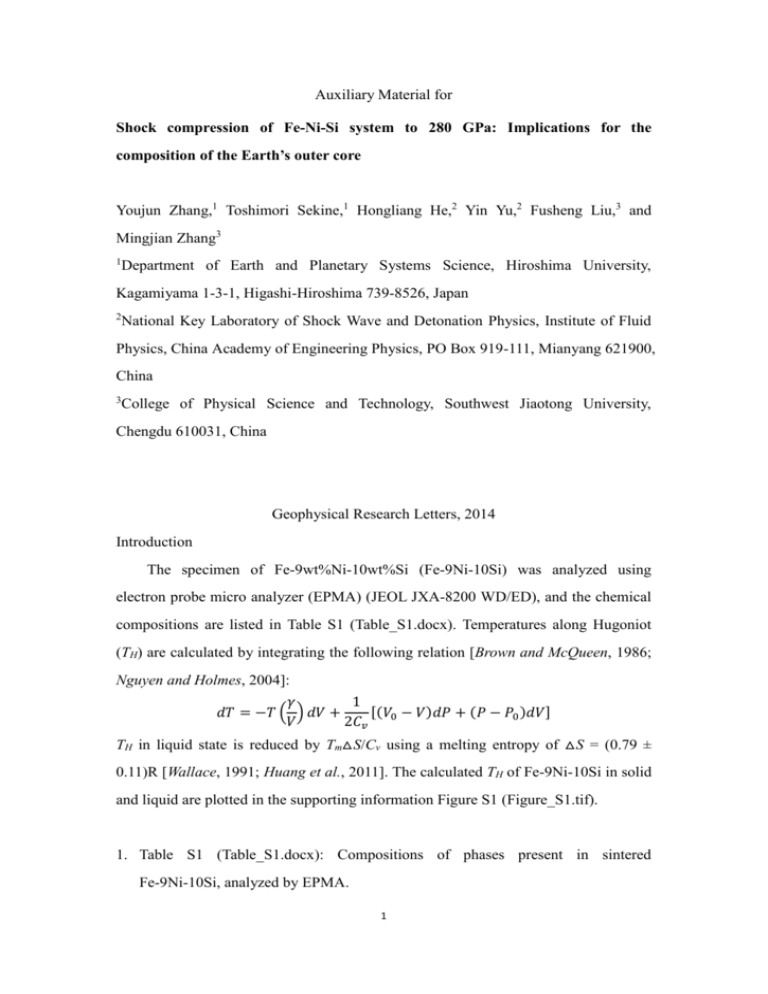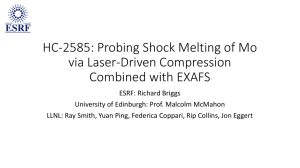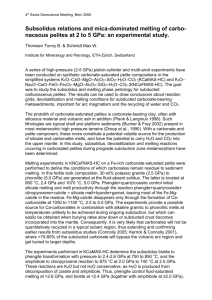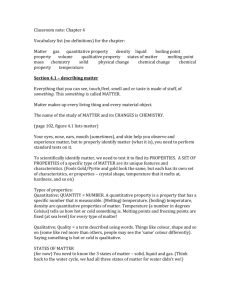Auxiliary_material_readme
advertisement

Auxiliary Material for Shock compression of Fe-Ni-Si system to 280 GPa: Implications for the composition of the Earth’s outer core Youjun Zhang,1 Toshimori Sekine,1 Hongliang He,2 Yin Yu,2 Fusheng Liu,3 and Mingjian Zhang3 1 Department of Earth and Planetary Systems Science, Hiroshima University, Kagamiyama 1-3-1, Higashi-Hiroshima 739-8526, Japan 2 National Key Laboratory of Shock Wave and Detonation Physics, Institute of Fluid Physics, China Academy of Engineering Physics, PO Box 919-111, Mianyang 621900, China 3 College of Physical Science and Technology, Southwest Jiaotong University, Chengdu 610031, China Geophysical Research Letters, 2014 Introduction The specimen of Fe-9wt%Ni-10wt%Si (Fe-9Ni-10Si) was analyzed using electron probe micro analyzer (EPMA) (JEOL JXA-8200 WD/ED), and the chemical compositions are listed in Table S1 (Table_S1.docx). Temperatures along Hugoniot (TH) are calculated by integrating the following relation [Brown and McQueen, 1986; Nguyen and Holmes, 2004]: 𝛾 1 [(𝑉 − 𝑉)𝑑𝑃 + (𝑃 − 𝑃0 )𝑑𝑉] 𝑑𝑇 = −𝑇 ( ) 𝑑𝑉 + 𝑉 2𝐶𝑣 0 TH in liquid state is reduced by Tm△S/Cv using a melting entropy of △S = (0.79 ± 0.11)R [Wallace, 1991; Huang et al., 2011]. The calculated TH of Fe-9Ni-10Si in solid and liquid are plotted in the supporting information Figure S1 (Figure_S1.tif). 1. Table S1 (Table_S1.docx): Compositions of phases present in sintered Fe-9Ni-10Si, analyzed by EPMA. 1 2. Figure S1 (Figure_S1.tif): The calculated temperature along Hugoniot for Fe-9Ni-10Si. The temperature curves for the solid and liquid Fe-9Ni-10Si intersects the extrapolated melting temperature curve of Fe-9Si [Fischer et al., 2014] at about 168 GPa (4800 ± 500 K) and ~206 GPa (5300 ± 500 K), respectively. Open red and black circles: lower and upper bounds on melting of Fe-9Si [Fischer et al., 2014]. Red and black triangles: lower and upper bounds on melting of Fe-5Ni-10Si [Morard et al., 2011]. Reference: Brown, J. M., and R. G. McQueen (1986), Phase transitions, Grüneisen parameter, and elasticity for shocked iron between 77 GPa and 400 GPa, J. Geophys. Res.: Solid Earth (1978–2012), 91(B7), 7485-7494. Fischer, R. A., A. J. Campbell, D. M. Reaman, N. A. Miller, D. L. Heinz, P. Dera, and V. B. Prakapenka (2013), Phase relations in the Fe–FeSi system at high pressures and temperatures. Earth Planet. Sci. Lett., 373, 54-64. Huang, H., Y. Fei, L. Cai, F. Jing, X. Hu, H. Xie, L. Zhang, and Z. Gong (2011), Evidence for an oxygen-depleted liquid outer core of the Earth. Nature, 479(7374), 513-516. Morard, G., D. Andrault, N. Guignot, J. Siebert, G. Garbarino, and D. Antonangeli (2011), Melting of Fe-Ni-Si and Fe-Ni-S alloys at megabar pressures: implications for the core–mantle boundary temperature, Phys. Chem. Miner., 38(10), 767-776. Nguyen, J. H., and N. C. Holmes (2004), Melting of iron at the physical conditions of the Earth's core, Nature, 427(6972), 339-342. Wallace, D. C. (1991), Entropy of liquid metals, Proc. R. Soc. Londo, Ser. A, 433(1889), 615-630. 2











